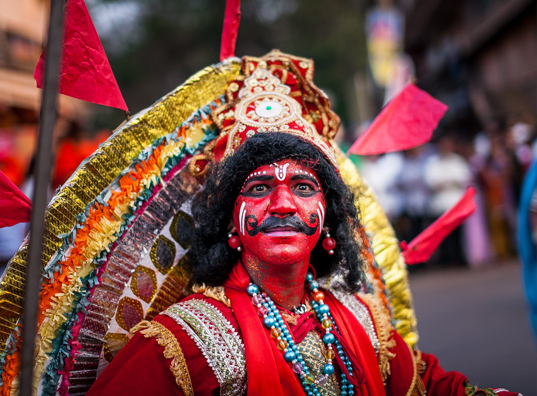India is known for its diverse culture and traditions, which are reflected in the various festivals celebrated throughout the year. One such festival is ‘Shigmotsav,’ also known as ‘Shigmo,’ which is celebrated with great enthusiasm in Goa.
Shigmotsav marks the arrival of spring and the end of the winter season. It is celebrated on the full moon day during the month of March, which is the last month of the Hindu calendar. The festival is usually observed 14 days before the festival of colors, Holi.
During Shigmotsav, people from different communities come together to celebrate the beauty of nature and express gratitude towards it. The festival is marked by vibrant processions, traditional dances, and music performances. People dress up in colorful attire and carry multi-colored flags as they march through the streets. The festivities continue for five days and end with a grand finale.
Significance of Shigmo Festival in Goa
Shigmotsav is celebrated by people from all walks of life, including farmers, fishermen, and artisans. The festival is an excellent opportunity for tourists to witness the rich cultural heritage of Goa and experience the local way of life.
In addition to the colorful processions and cultural performances, visitors can also indulge in traditional Goan cuisine during the festival. The delicacies served during Shigmotsav include savory snacks, sweets, and refreshing drinks, all made using local ingredients.
Overall, Shigmotsav is an exciting and vibrant festival that showcases the unique cultural heritage of Goa. If you are planning to visit Goa in March, do not miss the opportunity to witness this colorful and joyous celebration of nature and life.
What are Shigmoutsav Floats?
The unique aspect of Goa is that all these festivals are celebrated with much pomp and zest. This festival has been celebrated in Goa since 1979. This celebration clearly indicates its association with the local deities and the wealth of nature. The Hindu Goan ethnicity begins the celebration with a collective prayer and naman, where they kneel together making a vow, shunning intoxicants and non-vegetarian food – from the ninth moon day up to the full moon day. On the eleventh Moon day until the fifteenth moon day villagers assemble in their multi-colored attires setting the mood for festivity with column-like red-spotted flags – ‘Dhwaja’, beating the drums and blowing flutes together at the village temples, and performing dances within the temple courtyards while singing various folk songs. The celebration starts in the afternoon and goes on until the moon shines high in the sky.

In Goa, Shigmotsav is celebrated across 5 days, with the gaiety of one-day carnivals that takes place on the main road of Panjim, Mapusa, Vasco & Margao on each day. They become an eye-pleasing treat for tourists traveling during these months.
Holi – A Festival of Colors
The Shigmo Festival in Goa is a color festival celebrated in the month of “Falgun” as per Saka Calendar. During this festival period famous temple “Yatras” are held. Processions are carried out at temples by throwing “gulal” and dancing with god and goddess umbrellas and “Dindis”. This festival celebration is organized in different cities to attract tourists. Processions are carried out in cities with traditional Goan dances and modern floats. People are honored for the best performance in the procession and best float decorators.

Being celebrated in the villages, the “Shigmotsav” or Shigmo festival, a grand five-day festival of colors, is also considered as the spring festival of Goa. Its celebrations begin with the Holi, the festival of colors celebrated across the country. The festival commemorates the homecoming of the warriors who had left their homes and families at the end of Dussera to fight the invaders.
During the Shigmo festival ripening of the winter crop is also included as a reason for the festivities. By the time it was dusk, artists displayed the martial dances like ‘Ghode-modni’ or the horse dance. Floats depicting the themes from ancient Hindu scriptures came to delight the crowd. People participate in it while performing the ‘Rommatamel’ and ‘Fugdi’ dances. The Shigmo festival is celebrated by villages after farming.

When Is Shigmotsav in Goa?
Shigmo festival 2023 Goa would be celebrated in the month of Phalgun (March), beginning on the 9th moon day to the full moon day. The festival begins with the Naman (song) and the collective obeisance of the villagers. On the first day, the village deity is bathed and dressed in saffron robes. The 5th day is called ‘Rang Panchami’. This day of rejoicing is celebrated with the profuse use of ‘Gulal’ or red powder. People smear gulal on each other as a gesture of greeting.
On the 11th to 15th day, the villagers, clad in vibrant clothes carry dhwajas or torans. While beating drums and blowing the flutes, they assemble at the village temples. They perform the various folk dances like the Ghode-Morni or the horse dance, Talgadi, Hanpet, Lamp dance, Gopha(Goff). Rommatamel and Fugdi dances are performed by the villagers as part of the festivity. The intricately crafted floats form a major part of the festival.

The spring festival of Shigmo will begin on March 8, 2023, with the first parade being held at Ponda, in accordance with tradition. Promising an immersive experience, the parade will come to Panjim on March 11, 2023.
This year, there will be approximately 17 major and minor centres, with the major centres being Ponda, Vasco, Mapusa and Panjim.
Also Read: Carnival in Goa – A Goan Festival. Don’t forget to follow us on Instagram to watch few amazing videos of unseen Goan beauty.





